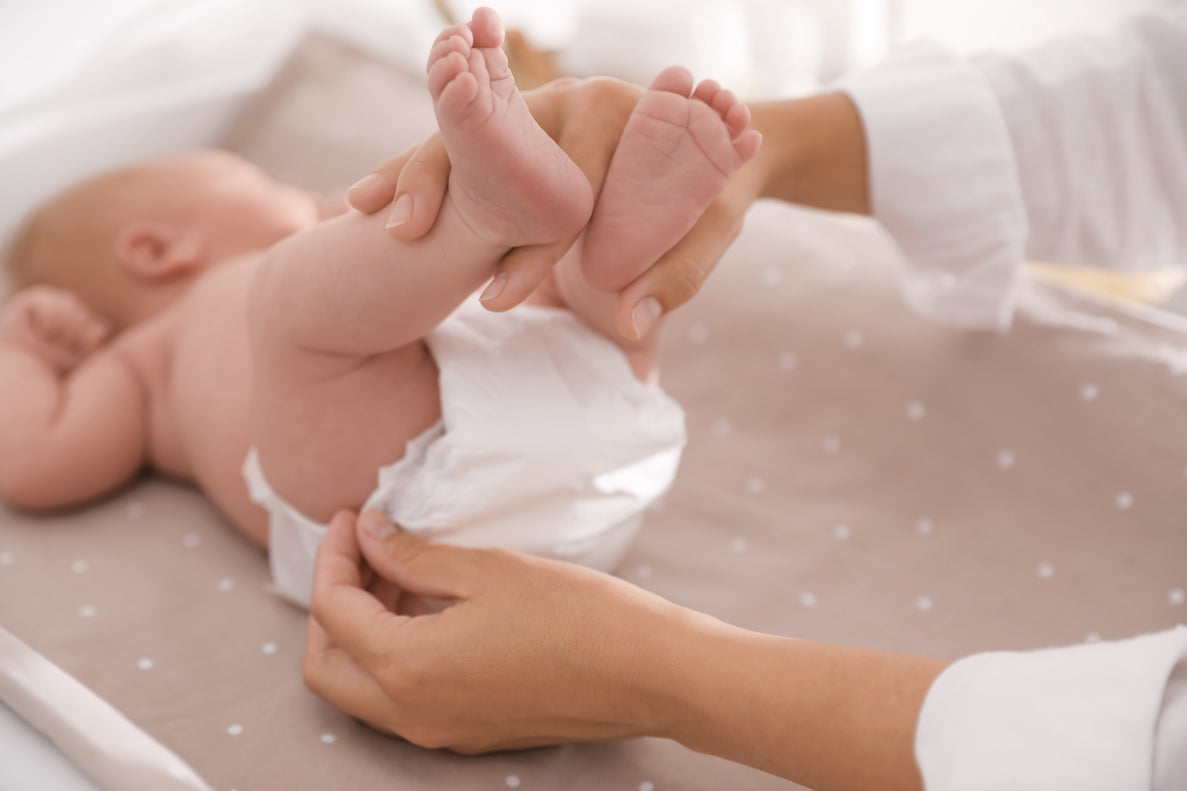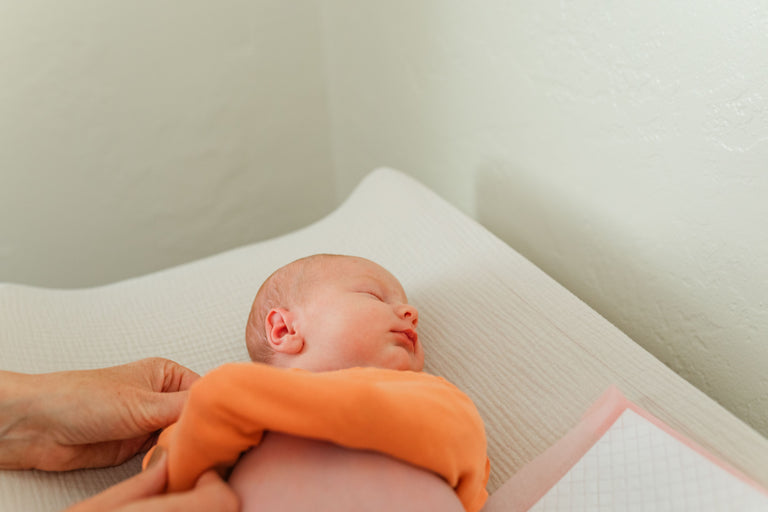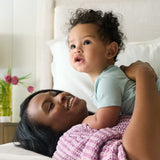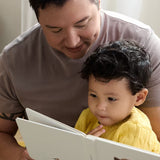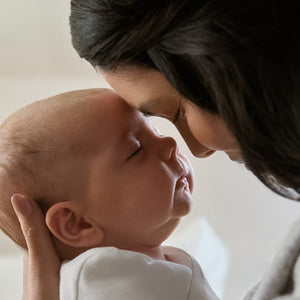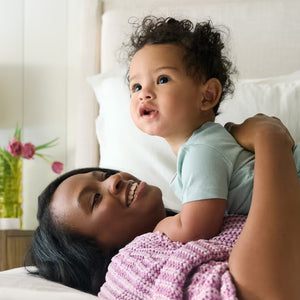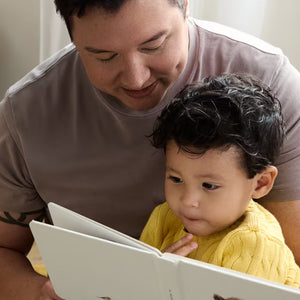Are you looking for help with diaper changes? Let’s discuss how to change a diaper, how often you should change a diaper, what to do if your baby hates diaper changes, the best for newborns (and older babies), what to do if your baby has a diaper rash, and so much more!
Be sure to join my Instagram and Facebook communities for more baby and toddler tips and tricks!
How to change a diaper
Changing a baby’s diaper seems like a simple task, but if you’ve never changed a diaper before it can seem daunting the first few times. Don’t worry, you’re sure to get plenty of practice! Let me show you how to change a baby’s diaper step by step:
How to change a diaper step by step:
Step 1: Get Ready.
Collect all of the items you might need to change your baby’s diaper. Lay your baby down on their back on a changing pad, blanket, or towel, and remove your baby’s clothes below the waist.
Step 2: Prepare the new diaper.
Lay a clean diaper under your baby’s bottom before you open the dirty diaper. (Wondering how to tell the front of the diaper from the back? The tabs that will secure the diaper closed are always on the backside of the diaper.)
Step 3: Clean up your baby.
Open your baby’s dirty diaper, and pull the front of the diaper down, leaving the back of the diaper under your baby’s bottom. Use wipes to clean your baby in a front-to-back direction. Apply any diaper cream, if needed.
Step 4: Contain the mess.
Remove the dirty diaper from under your baby’s bottom and clean any other mess. Place dirty wipes in the dirty diaper, roll the diaper up, and use tabs to close the diaper into a ball.
Step 5: Secure the clean diaper.
Close the diaper (it will come up to about your baby’s belly button) and fasten the tabs on either side of the diaper. You want the diaper to be tight enough to keep in any mess, but not so tight that your baby is uncomfortable. You should be able to put 1-2 fingers between the diaper and your baby’s belly. Check that the “ruffles” on your baby’s diaper are pulled out.
Step 6: Dress your baby and throw away the soiled diaper.
Toss it into a plastic bag before placing it in a trash can to help contain the smell.
Let me walk you through a diaper change:
Wondering about when and how to handle diaper changes in the night? I answer your most common questions in my blog on Changing Diapers at Night.
Diaper changing hacks and tips
Changing a diaper is pretty straightforward, however, there are some hacks and tips that can make the process easier based on the age of your little one.
Tips for diaper changes for newborns
-
Consider the umbilical cord: Before the umbilical cord stump falls off, fold the top of the diaper inwards so that it isn’t touching your baby’s belly button.
-
Prevent pee showers: Before opening the diaper, swipe a wet wipe across your baby’s lower belly. This can help them to pee again right before you open the diaper (instead of peeing on you).
-
Warm the wipe before using: Hold the wipe in your hand for a few seconds to warm it up before wiping your baby.
-
Use a double diaper hack: Place the clean diaper under the current diaper that your baby is wearing before you begin the changing process. Once you’ve cleaned your little one and removed the dirty diaper, the new one is already in position to be put on.
-
Add a mobile to your changing area: Instead of hanging the baby mobile over your little one’s crib, hang it above the changing table/pad in their room. This will give them something interesting to look at during changes.
-
Avoid rushing: Most newborns will cry during a diaper change; this is normal. Try not to rush through the diaper change, as this will feel frantic to your baby. Instead, go through the steps and talk to your little one in a calm/soothing voice.
-
Aim down: If you have a baby boy, be sure his penis is aimed down into the diaper rather than up towards the top of the diaper. We want pee going into the absorbent part of the diaper rather than up and out.
-
Fold the back of the diaper down. If your baby’s diaper doesn’t have a blowout “pocket” in the back, fold over the top of the diaper in the back to prevent blowouts.
-
Use a diaper cream brush. A silicone diaper cream brush helps spread the diaper cream evenly and keeps your hands clean when applying diaper cream.
-
Contain the smell: Toss your baby’s dirty diaper into a plastic bag before placing it in a trash can to help contain the smell.
Expert Tip: Your baby’s first poop, meconium, is black and tarry. This makes it hard to wipe off. When your baby is born, apply coconut oil or diaper cream to their bottom and repeat with each diaper change. This helps protect their sensitive skin and makes changing that first diaper much easier.
Tips for diaper changes for babies
-
Move up a size in diapers to prevent blowouts: If your baby is frequently having leaks or blowouts, this may mean they are ready to move up a size in diapers. Look at the front of the diaper for the built-in indicator: it’s usually in the spot where you secure the tabs of the diaper. Check your diaper box to see what this is for the brand you use!
-
Add excitement: Turning on or singing a silly song can help distract your baby during the diaper change and make it more enjoyable for them.
-
Keep hands busy: Give them a toy or extra diaper to hold to help keep their hands busy and out of the diaper area. A children’s electric toothbrush can be a fun distraction from the diaper change. Let them hold onto it while you change their diaper. You can even let them pick out the toothbrush at the store!
-
Contain flailing arms: If your baby is wearing a onesie, you can pull the bottom of their onesie up and tuck their arms in to keep the arms more contained.
Image gallery
Tips for older babies and toddlers
-
Try a different diaper style: You can use a pull up style diaper for your busy baby/toddler (Pampers 360 and Millie Moon training pants). Using a pull-up style diaper can make the process a bit faster! Pull up diapers can still tear apart at the sides to be changed like a normal diaper, but are easy to change standing up (when wet) and pull up like underwear.
-
Encourage self-dressing skills: After getting your toddler clean, you can put on the new diaper while they are standing. This can help prepare your little one for self-dressing skills and potty training!
-
Use a “first, then” statement. First, we are going to change our diaper, and then we are going to go play with ___!
-
Let them help: Let them help you get the supplies ready. Including your toddler in daily routines can help prevent protests!
Expert tip: Most diapers now have a “wetness indicator” on the front of them! This typically looks like a faint yellow line down the front of the diaper that will turn blue when it is wet.
What are the best diapers?
There are so many different brands and types of diapers, so I know it can feel overwhelming. You may find yourself switching brands a few times before finding the best one for your family, but here are some of my favorites!
Best diapers for newborns
Consider trying a few different brands of diapers. Everyone has their own preference, and this will help you learn what works best for your baby!
Here are some of the most recommended diapers for newborns:
-
Huggies Special Delivery Diapers
-
Huggies Little Snugglers Diapers
-
Honest Company Clean Conscious Diapers
-
Millie Moon Luxury Diapers
Best cloth diapers
If cloth diapers are the right fit for your family, there are some things to consider when picking a brand. You will want to consider if the cloth diapers require stuffing, how you wash the diapers (Do they need line drying?), if the diapers can adjust for your little one’s size and growth, and the shape of the diaper.
Here are some of the most recommended cloth diapers:
-
Charlie Banana Reusable Cloth Diapers
-
Kanga Care Rumparooz Cloth Pocket Diapers
-
OsoCozy Prefolded Cloth Diapers
-
Thirsties One Size All-in-One Cloth Diaper
Best eco-friendly diapers
For families who prefer eco-friendly or non-toxic products, here are some of the most recommended eco-friendly diapers:
-
Honest Company Clean Conscious Diapers
-
Dyper Simply Kind Diapers
-
Andy Pandy Bamboo Disposable Diapers
-
Coterie Diaper
-
HealthyBaby Diapers
Best diapers for sensitive skin
If you have a little one with sensitive skin, you’ll want to look for a hypoallergenic diaper and wipes.
Here are some of the most recommended diapers for babies with sensitive skin:
-
Honest Company Overnights
-
Huggies Special Delivery Diapers
-
Millie Moon Luxury Diapers
-
Coterie Diaper
Best overnight diapers
Overnight diapers can be great for preventing diaper leaks overnight. Many families find it helpful to use a diaper one size larger at night than you do during the day. You’ll just want to make sure that the tabs are fastened snugly around their lower belly.
Here are some of the most recommended overnight diapers:
-
Huggies Special Delivery Diapers
-
Huggies Overnites Diapers
-
Goodnites (training pant style for toddlers)
Expert Tip: Still struggling with nighttime leaking? Try adding a Sposie insert to your baby’s diaper.
Best diapers for blowouts
To help prevent blowouts, make sure you’re using the correct size and that the ruffles around your baby’s legs are pulled out. You’ll also want to look for a diaper that has a “pocket” on the backside that helps to prevent leaking.
Here are some of the most recommended diapers to prevent blowouts:
-
Huggies Little Snugglers Diapers
-
Huggies Little Movers Diapers
-
Kirkland Signature Diapers
Best diapers for toddlers
If you have a toddler still in diapers, you can pick between a traditional style diaper or a training-pants style diaper.
Here are some of the most recommended diapers for toddlers:
-
Pull-Ups Training Pants
-
Mille Moon Training Pants
-
Kirkland Signature Diapers
Best baby wipes
Just like with diapers, you may need to try out a few before finding the right ones for your baby. I do find that most babies do best with unscented baby wipes.
Here are some of the most recommended baby wipes:
-
Water Wipes Baby Wipes
-
Huggies Natural Care Wipes
-
The Honest Company Clean Conscious Wipes
-
Kirkland Signature Baby Wipes Fragrance Free
Best diaper cream
Diaper cream is a product you will want to have on hand for the first few years of your baby’s life in case of diaper rash!
Here are some of the most recommended diaper creams:
-
Chelsey Wang Baby Diaper Cream
-
Tubby Todd Sweet Cheeks Diaper Paste
-
Desitin Maximum Strength
-
Bordeaux’s Butt Paste
-
Honest Company Organic Baby Diaper Rash Cream
-
Triple Paste Diaper Rash Cream
-
Active Skin Repair Baby
Expert Tip: Diaper cream is really thick and can be difficult to clean off your hands. Using a silicone diaper cream applicator can make applying diaper cream much easier!
What do I put in a diaper caddy or changing station?
Consider having a diaper caddy or a changing station on each level of your house or in the areas where you spend the most time. This can make those frequent diaper changes in the newborn stage a little easier. Here is what I recommend you keep in your diaper caddy:
-
Diapers
-
Wipes
-
Diaper changing pad
-
Diaper cream
-
Diaper cream applicator
-
2-3 clean outfits
-
Plastic bags for messy diapers
You can find some of my favorite products for a diaper caddy here.
Expert Tip: Keep a diaper caddy in your car as well! You may not use it often, but it can be a life saver for when you accidentally forget the diaper bag or run out of diapers when you are out of the house!
How long can a baby stay in a poopy diaper?
Ideally, you’ll change your baby’s dirty diaper as soon as you can. It’s okay to wait a few minutes if you’re in the middle of something. But if possible, change your baby’s diaper within ten minutes of knowing it’s dirty. This will help keep your baby comfortable and avoid diaper rash. I understand there may be times when this simply isn’t possible. Please don’t feel guilty. Just change their diaper as soon as you can.
What should I do if my baby has a diaper rash?
Diaper rash is something that all babies will have at one time or another. When a diaper rash happens, the goal is to keep the affected area dry and clean so that it can heal.
Ways to help diaper rash heal:
-
Have diaper-free time when possible!
-
Use a thick layer of diaper cream to create a barrier between the skin and moisture from a wet diaper. You can also try a layer of diaper cream against the skin and a layer of Aquaphor on top as an extra barrier.
-
Instead of wiping, try dabbing with the wipe to keep your little one more comfortable during the diaper change.
-
If your baby seems sensitive when you’re using wipes, consider a very soft, wet wash rag instead of wipes.
-
If your baby’s diaper is simply wet, it’s okay to skip the wiping to reduce the amount of irritation on the skin.
-
If a diaper change requires wiping and cleaning, use the clean diaper to fan the diaper area dry before placing the new diaper on.
Expert Tip: If you notice that your baby’s diaper rash has open wounds, is bleeding, or causing your little one significant discomfort, reach out to your pediatrician.
What should I do if my baby hates diaper changes?
I know it can be stressful when your baby screams anytime you change their diaper. Diaper changes are a necessity, so let’s look at some ways to help make them more pleasant:
-
Keep your baby as comfortable as possible. Little adjustments to keep your baby more comfortable can make a big difference. This may look like warming the baby wipes in your hands for a few seconds before wiping their diaper area or making sure the surface you’re using to change isn’t too chilly before laying them down. If you have a baby with reflux, consider rolling your baby to one side at a time to clean the diaper area instead of lifting their legs up towards their belly!
-
Distract your baby. Offering a distraction during your baby’s diaper change could be all you need to make the process more enjoyable for both of you! This could be as simple as singing their favorite song, making silly faces, or handing them a small toy.
-
Don’t rush. When your baby is screaming during a diaper change, your first instinct is likely to get through it as quickly as possible. But instead of rushing, try going through the steps calmly as you talk your little one through what you’re doing!
Are you wanting more newborn, baby, and toddler tips and tricks? Be sure to join my Instagram and Facebook communities!

